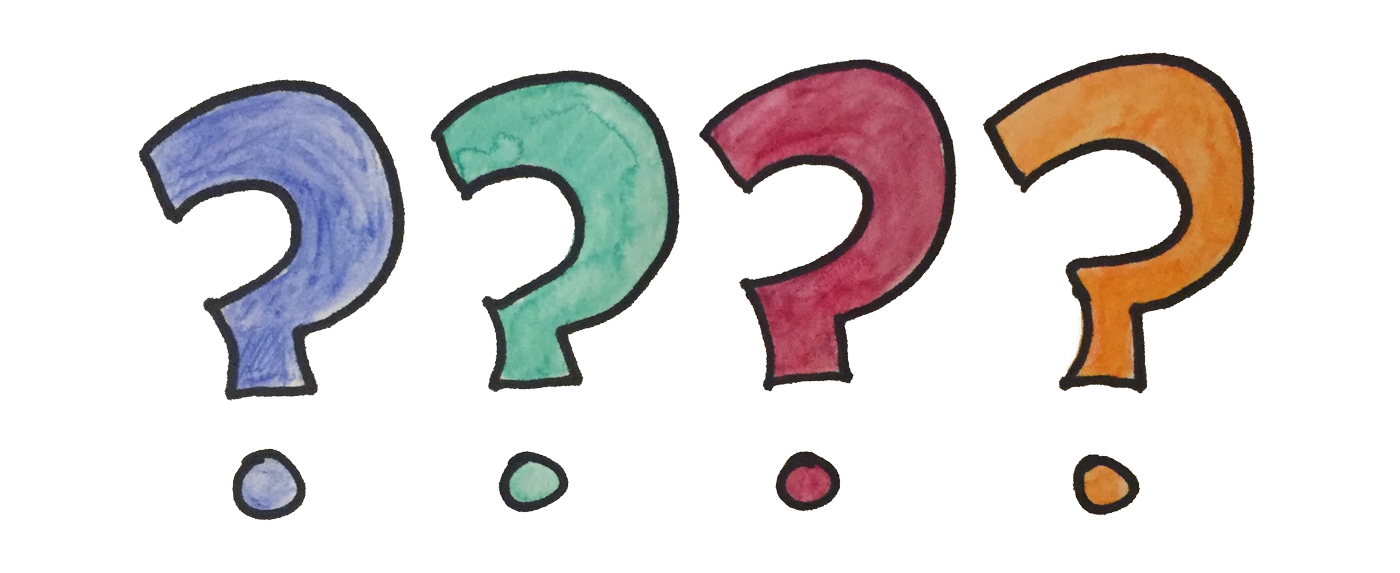I’m getting tired of the sound of my own voice. Continue reading My Voice is Frustrating Me
Tag: education
Insert Question Here
Questions are not a sign of ignorance, as many believe. Actually, they are smartest conversation tool we have.
Jewish rabbis are master teachers. They teach based on the individual. They rarely give students straight answers. Instead, they give a statement from which the answer can be inferred.
But the greatest teaching tool that a rabbi uses is the question. They believe rightly that a student who hears an answer out of the mouth of the teacher does not own the answer. Many will ask seemingly unconnected questions in order to lead individuals to find answers for themselves.
Ray Vander Laan, a teacher and an indirect mentor of mine, tells a beautiful story illustrating this point:
On a trip to the Holy Land, a woman stepped into a Jewish painter’s shop. Admiring the paintings, she asked the shop owner, “Which one is your favorite?”
The shop owner didn’t answer right away. Then he looked up at the woman and asked, “Are you married?”
Not the kind of answer an American looks for. But the woman replied, “Yes. Why?”
Insert: if she had not finished her answer with “Why?” the shop owner would have said “Ok”, and that would have been the end of the conversation. A big part of Jewish teaching requires a student to want the answer badly enough to keep seeking it out. No rabbi speaks unnecessarily.
“Do you have children?” the painter continued.
“Yes. I have three. Why?” the woman wondered.
“Which of your children is your favorite?”
Boom. Not once did the Jewish painter have to make a statement. The woman left the shop with a profound understanding of the owner’s attachment to his paintings. He didn’t have to go into long philosophical arguments about how he had poured his soul into each painting, and given each his best. In fact, his questions left a greater impact on the woman by connecting to her heart.
The power of the question is extremely underrated. Everyone has go to’s: “How are you?” “What’s up?” “How’s the weather?” But no one dares to ask good questions.
That is, except for children. They are full of curiosity, examining the world around them and questioning everyone that comes in sight.
What changes between childhood and adulthood? Many times children are shamed for making inquiries. That shame takes over culture, and by the time a generation of kids is grown up, we have a civilization who thinks it is a sign of weakness to ask a question.
I say that good questions are the strongest communication technique available to us. Why?
Questions engage.
Humans by nature like to talk about themselves. A good question directs attention toward the other person, sparking individual passions and desires. When you engage a person’s brain, he retains more information. Besides, everyone likes speaking with someone who stirs their thoughts.
Questions connect.
By showing interest in another person’s life, you create a connection point to that person. The best conversations happen when both parties are engaged in the discussions. The more people feel you have in common, the more they will gravitate toward you.
Questions Inspire.
Engaging conversations lead to strong connections. Strong connections birth ideas. That’s what relationships are all about: creating value for the world through the combined force of minds and souls.
Take the time to ask good questions. Here are several to get your brain going:
- What did you learn today?
- What do you know that I don’t?
- What do you think about (insert common topic)?
- Do you have any current projects you’re working on?
- How do you like to learn?
- What are you currently studying?
- Who is your favorite thinker?
- What is your favorite book?
- What is the best aspect of today’s culture?
- What do you wish people knew that they don’t?
- How do you stay productive?
- Would you rather (insert icebreaker paradox)?
- Is important to know history in order to understand culture?
The things can ask anyone are endless. Use these ideas to strengthen the relationships around you. Stop letting the lie of weakness quell your questions.
Musings: Music
Final Project Overview
Module 2 of the Praxis boot camp challenges each participant to complete a portfolio project. Projects are learning in action. Participants build new skills and showcase them through the projects they create.
My project was a podcast. Or in better terms, my project is a podcast. This venture will be the focus of the next six months of my life. As of today, I have completed four interviews. They will all be released during the month of April.
But I wanted more than just a podcast. I needed to show something at the end of the month for all my hard work. So I added a sales spin to the heart of my project.
What are the biggest things that many people in sales struggle with? What do many think when the word “sales” pops into their head? Cold calls. Cold emails. Reaching out directly to people about a product or service.
I decided to jump off a limb and run right into those issues that scare every person seeking a sales career. So I created a list of all my phone and email contacts. The ones I could call, I did. Otherwise, I sent them emails.
In the emails I sent, I pitched my podcast. I tried to develop an approach that would reach each individual on a personal level. For some, I spent considerable time detailing the idea behind the podcast. For others, I created a conversation surrounding other events in their lives. I focused on connecting directly to the person behind the email I was sending. Then I asked to add their email address to my mailing list.
I found that it takes a large amount of time to create an email that is personalized. The 50 emails I sent during the month of February took an average of 15 minutes of my time apiece. Out of the 50, I got 20 positive answers. Only 1 who answered declined the offer of being added to my mailing list. (However, he was a perfect candidate to interview, so I benefited from the email either way.) The other 29 simply did not answer.
Maybe those people felt bad telling me that they didn’t want to join one more list. Maybe they thought my email was spam. Regardless, I developed a new desire to be competent and quick with my email communication. I appreciated the one “no” I got more than the emails that never got a reply.
I also made 30 cold calls over the course of the month. 14 of those 30 calls were never answered. I left voicemails and sent texts to the numbers I didn’t get through to. Out of the other 16 calls, I only got a negative answer from 1. I successfully added the other 15 people to my email list.
When averaging the amount of time I spent calling phones and typing emails, the end result was 25-30 minutes of time spent on each email added to my list. Maybe if I was older and busier this project would have taken too much time. For many people, the cost would have been too high per email to be considered worth the time. But for me, it was so, so worth it.
- I introduced my podcast to 80 people.
- I became comfortable with cold calls.
- I learned to streamline an email process while keeping each email personal.
- I increased my network by spending time connecting with people I haven’t talked to in awhile.
- I built an email list of 35 people (and counting).
To a teenager who is passionate about teaching people and learning, and whose goal is to build relationships, every minute was worth it.
Soul on Paper
I’ve always looked at reading a book like a conversation between author and reader. Through reading, you have the golden opportunity of communicating with people that are separated from you by time and space.
However, I didn’t realize the truth of this statement in my actions. As a young teenager, I read a lot of classic fiction. I would speed-read the chapters, sigh at the end, and leave unchanged.
Thinking back, I wonder: was it the books I was reading that didn’t change me, or was it my attitude toward the reading process? Even fiction books have deep underlying philosophical issues they address. Was I doing justice to the books I read by simply reading them and putting them away? Continue reading Soul on Paper
From Mennonite Kid to Self-Educator
I have always enjoyed learning. Many kids hated school; I loved every minute. However, I never went to a traditional public school. The first six years of my life were spent in a small private school in association with the Mennonite church my father was a pastor of. Continue reading From Mennonite Kid to Self-Educator
Perfection or Constant Growth?
I haven’t read the book Art and Fear, but I have learned a valuable lesson from the book without even opening its cover. There’s an anecdote about an art teacher that holds a valuable lesson for all of life, not just content creation:
“The ceramics teacher announced on opening day that he was dividing the class into two groups. All those on the left side of the studio, he said, would be graded solely on the quantity of work they produced, all those on the right solely on its quality.
His procedure was simple: on the final day of class he would bring in his bathroom scales and weigh the work of the “quantity” group: fifty pound of pots rated an “A”, forty pounds a “B”, and so on. Those being graded on “quality”, however, needed to produce only one pot – albeit a perfect one – to get an “A”.
Well, came grading time and a curious fact emerged: the works of highest quality were all produced by the group being graded for quantity. It seems that while the “quantity” group was busily churning out piles of work – and learning from their mistakes – the “quality” group had sat theorizing about perfection, and in the end had little more to show for their efforts than grandiose theories and a pile of dead clay.” (Source)
We’ve been told all our lives to look at the big picture; there’s nothing wrong with that. But in the process of trying to see the big picture, we have begun obsessing over what it should look like.
Here’s the big deal: spending time worrying about making something perfect takes time away from actually creating value in life. But when you are focused on building and creating, you can’t help but to advance each day. Perfection is an illusion. But constant growth is not. The people who are obsessed with the illusion are the ones who will grow the least.
Maybe, instead of trying to make one perfect big picture, we should focus on each day as a figurative lump of clay ready to be molded. Each project, every idea, each relationship is its own work of art. Instead of sitting around spending time theorizing about what exactly your life’s masterpiece should be, create value on the canvas in front of you.
You’re the artist; go find your canvases.
Photo by Anna Jahn on Unsplash
Curiosity: an Education in Itself
“The important thing is not to stop questioning. Curiosity has its own reason for existing.” -Albert Einstein
One of the greatest minds of all time gives the credit for his genius to being passionately curious. Learning, at its core, consists of being curious about something and building new pathways due to this curiosity.
Then how did humanity get off track? I can’t count how many times I have heard parents shut down their inquisitive 6 year olds by saying, “You ask too many questions.” (Normally, this answer is also a cover for, “I don’t know the answer to your question but I don’t want to admit it.”) Continue reading Curiosity: an Education in Itself
Networking: my Learning Trend
![]()
It’s interesting to watch the trends of information that flow through my life. Sometimes it’s intentional: I’m learning a lot about Mark Twain because of working on a research project with my sister. Other times, the trends are entirely unintentional: all of a sudden a flood of knowledge on a certain subject comes from numerous sources.
I can’t explain the trends. Maybe it’s simply that when my interest is piqued, I start to notice new information that I wouldn’t have seen before. Maybe, subconsciously, I am searching out for the certain knowledge that attracts me. Maybe it’s just God’s divine hand guiding my learning process. Regardless of the cause, I love it. It’s exhilarating to take a step back and watch the process of learning become real in my life.
One of these trends has been the concept of tribe. When I read about tribe in the book The Last Safe Investment, I immediately connected with the idea. Tribe refers to the close group of individuals with whom you share much in common. Tribe is not just a friend group: it is a close circle of people who are committed to growing together.
This started the trend of networking information in my head. It awakened within me the passion to make each connection that I make as strong as possible. Instead of simply thinking of a friend as a friend, I choose to actively grow them and help them succeed. Being intentional with connections makes for strong, healthy friendships and partnerships.
Soon after reading the book I listened to a networking talk by Evan Le at a Praxis conference. Over the next several months, random people reached out to me because of things I wrote or people we both knew, and I realized anew how important it was to strengthen each connection, both business and personal.
This isn’t hard to do. I naturally relate to people, and I have always sought to bring out the best in everyone I am with. However, the difference lies in intentionality. I can’t just wait for people to reach out to me and expect to build a strong network. I have to actively seek to build relationships.
It’s this trend that has led me to pursue direct connection with everyone who chooses to join my podcast mailing list. And I am enjoying it to the full.
What learning trends have you seen in your life? Drop a comment or reach out to me!
Project Update 02/23/2018

The past couple days have been full of cold calls and emails. I’m building the basic sales skills while connecting with others over a mission I am extremely passionate about. Continue reading Project Update 02/23/2018






